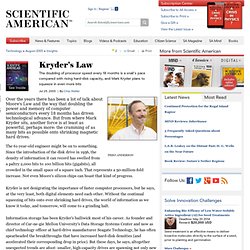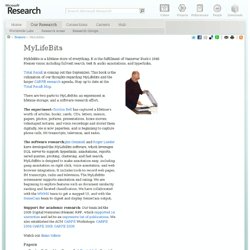

Kryder's Law. Over the years there has been a lot of talk about Moore's Law and the way that doubling the power and memory of computer semiconductors every 18 months has driven technological advance.

But from where Mark Kryder sits, another force is at least as powerful, perhaps more: the cramming of as many bits as possible onto shrinking magnetic hard drives. The 61-year-old engineer might be on to something. Since the introduction of the disk drive in 1956, the density of information it can record has swelled from a paltry 2,000 bits to 100 billion bits (gigabits), all crowded in the small space of a square inch. That represents a 50-million-fold increase. Not even Moore's silicon chips can boast that kind of progress.
Kryder is not denigrating the importance of faster computer processors, but he says, at the very least, both digital elements need each other. Information storage has been Kryder's bailiwick most of his career. Such devices may relegate Moore's Law to secondary status. Www.emc.com/collateral/analyst-reports/expanding-digital-idc-white-paper.pdf. Executive Summary. How much new information is created each year? Newly created information is stored in four physical media print, film, magnetic and optical and seen or heard in four information flows through electronic channels telephone, radio and TV, and the Internet. This study of information storage and flows analyzes the year 2002 in order to estimate the annual size of the stock of new information recorded in storage media, and heard or seen each year in information flows.
Where reliable data was available we have compared the 2002 findings to those of our 2000 study (which used 1999 data) in order to describe a few trends in the growth rate of information. Print, film, magnetic, and optical storage media produced about 5 exabytes of new information in 2002. Ninety-two percent of the new information was stored on magnetic media, mostly in hard disks. Source: Many of these examples were taken from Roy Williams Data Powers of Ten web page at Caltech. Source: How much information 2003 A.
B. C. D. Hmi.ucsd.edu/pdf/HMI_2009_ConsumerReport_Dec9_2009.pdf. MyLifeBits. Total Recall is coming out this September.

This book is the culimation of our thoughts regarding MyLifebits and the larger CARPE research agenda. Stay up to date at the Total Recall blog . There are two parts to MyLifeBits: an experiment in lifetime storage, and a software research effort. The experiment: Gordon Bell has captured a lifetime's worth of articles, books, cards, CDs, letters, memos, papers, photos, pictures, presentations, home movies, videotaped lectures, and voice recordings and stored them digitally. He is now paperless, and is beginning to capture phone calls, IM transcripts, television, and radio. The software research: Jim Gemmell and Roger Lueder have developed the MyLifeBits software, which leverages SQL server to support: hyperlinks, annotations, reports, saved queries, pivoting, clustering, and fast search. Watch our demo videos Papers Gordon Bell and Jim Gemmell, A Digital Life , Scientific American, March 2007. Presentations MyLifeBits In The News Related links.
2015 nähert sich der jährliche Internetverkehr dem Zettabyte-Schwellenwert.